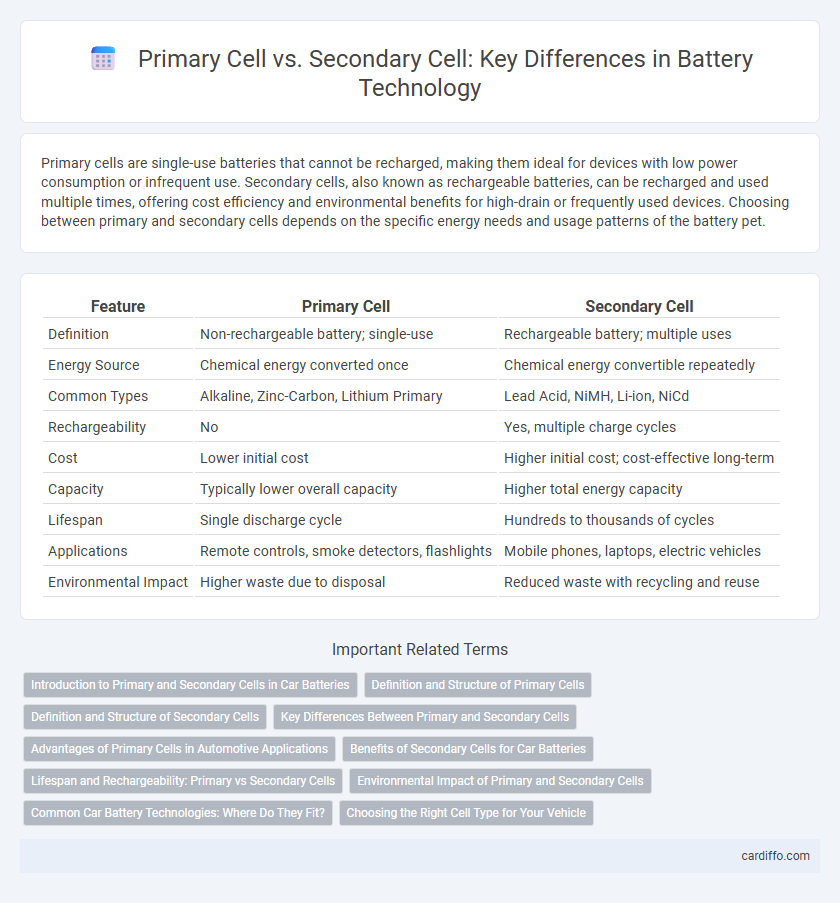Primary cells are single-use batteries that cannot be recharged, making them ideal for devices with low power consumption or infrequent use. Secondary cells, also known as rechargeable batteries, can be recharged and used multiple times, offering cost efficiency and environmental benefits for high-drain or frequently used devices. Choosing between primary and secondary cells depends on the specific energy needs and usage patterns of the battery pet.
Table of Comparison
| Feature | Primary Cell | Secondary Cell |
|---|---|---|
| Definition | Non-rechargeable battery; single-use | Rechargeable battery; multiple uses |
| Energy Source | Chemical energy converted once | Chemical energy convertible repeatedly |
| Common Types | Alkaline, Zinc-Carbon, Lithium Primary | Lead Acid, NiMH, Li-ion, NiCd |
| Rechargeability | No | Yes, multiple charge cycles |
| Cost | Lower initial cost | Higher initial cost; cost-effective long-term |
| Capacity | Typically lower overall capacity | Higher total energy capacity |
| Lifespan | Single discharge cycle | Hundreds to thousands of cycles |
| Applications | Remote controls, smoke detectors, flashlights | Mobile phones, laptops, electric vehicles |
| Environmental Impact | Higher waste due to disposal | Reduced waste with recycling and reuse |
Introduction to Primary and Secondary Cells in Car Batteries
Primary cells in car batteries are single-use electrochemical cells that provide power through irreversible chemical reactions, commonly used in applications requiring long shelf life and low maintenance. Secondary cells, also known as rechargeable batteries, utilize reversible chemical reactions allowing repeated charging and discharging cycles, making them essential for modern vehicles with higher energy demands. Car batteries predominantly employ secondary cells, such as lead-acid or lithium-ion types, to support engine starting, lighting, and ignition systems.
Definition and Structure of Primary Cells
Primary cells are non-rechargeable batteries designed for single-use, converting chemical energy into electrical energy through irreversible electrochemical reactions. Structurally, they consist of an anode, cathode, and electrolyte, with the anode undergoing oxidation and the cathode reduction until reactants are exhausted. Common examples include zinc-carbon and alkaline batteries, widely used in low-drain devices like remote controls and smoke detectors.
Definition and Structure of Secondary Cells
Secondary cells, also known as rechargeable batteries, consist of electrodes and an electrolyte that enable reversible chemical reactions, allowing the cell to be recharged multiple times. Their structure typically includes a cathode, anode, separator, and electrolyte, designed to facilitate ion flow during both discharge and recharge cycles. Unlike primary cells, secondary cells restore their chemical composition through electrical energy input, enhancing their longevity and cost-effectiveness in applications such as lithium-ion and nickel-metal hydride batteries.
Key Differences Between Primary and Secondary Cells
Primary cells are single-use batteries that cannot be recharged, commonly used in devices with low energy demands like remote controls and smoke detectors. Secondary cells are rechargeable batteries, designed for multiple charge-discharge cycles, making them ideal for smartphones, laptops, and electric vehicles. The primary difference lies in energy storage chemistry: primary cells rely on irreversible chemical reactions, while secondary cells utilize reversible reactions for reusability.
Advantages of Primary Cells in Automotive Applications
Primary cells offer superior shelf life and reliability in automotive applications due to their low self-discharge rates and stable voltage output, ensuring consistent performance over extended periods without maintenance. Their lightweight and compact design provides an advantage for emergency and backup power systems in vehicles, where quick energy delivery is critical. Primary cells also excel in harsh environments with minimal risk of leakage or damage, making them ideal for sensor and remote control devices within automotive systems.
Benefits of Secondary Cells for Car Batteries
Secondary cells offer significant advantages for car batteries due to their rechargeable nature, enabling repeated use and reducing overall battery replacement costs. These cells provide higher energy efficiency and better performance stability, ensuring reliable power supply for vehicle starting and electrical systems. Their long lifespan and environmental benefits from reduced waste make secondary cells the preferred choice for modern automotive applications.
Lifespan and Rechargeability: Primary vs Secondary Cells
Primary cells offer a limited lifespan as they are designed for single-use and cannot be recharged, making them ideal for low-drain or emergency applications. Secondary cells have a longer effective lifespan due to their ability to be recharged multiple times, providing cost-efficiency and sustainability for high-drain devices. Rechargeability significantly extends the usability of secondary cells compared to primary cells, which must be replaced once depleted.
Environmental Impact of Primary and Secondary Cells
Primary cells, designed for single-use, contribute significantly to environmental waste due to their non-rechargeable nature, leading to frequent disposal and accumulation in landfills. Secondary cells, or rechargeable batteries, reduce environmental impact by enabling multiple charge-discharge cycles, decreasing battery waste and resource extraction over time. The shift towards secondary cells supports sustainable battery usage by minimizing heavy metal contamination and conserving raw materials.
Common Car Battery Technologies: Where Do They Fit?
Primary cells, such as alkaline batteries, are designed for single-use applications and are rarely used in cars due to their limited rechargeability and lower energy density. Secondary cells, including lead-acid and lithium-ion batteries, dominate common car battery technologies because they provide rechargeable power essential for starting, lighting, and ignition systems. Lead-acid batteries remain prevalent in traditional vehicles for their cost-effectiveness and reliable cold-cranking amps, while lithium-ion batteries are increasingly popular in electric and hybrid vehicles for their higher energy density and longer cycle life.
Choosing the Right Cell Type for Your Vehicle
Selecting between a primary cell and a secondary cell for your vehicle depends on usage requirements and rechargeability; primary cells are single-use and ideal for low-drain applications, while secondary cells, commonly known as rechargeable batteries, suit high-drain, long-term vehicle needs. Lead-acid secondary batteries are standard in automotive starting, lighting, and ignition systems due to their robust recharge cycles and power output. For electric vehicles, lithium-ion secondary cells provide higher energy density and longer lifespan, making them the preferred choice for sustainable performance and efficiency.
Primary Cell vs Secondary Cell Infographic

 cardiffo.com
cardiffo.com